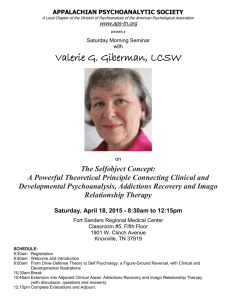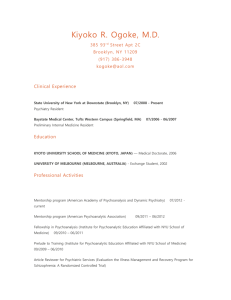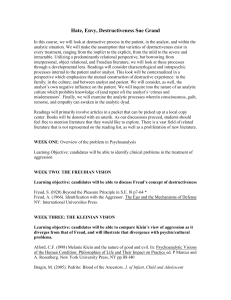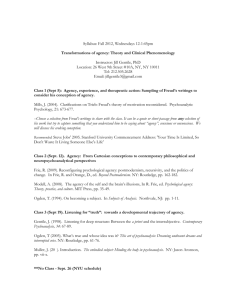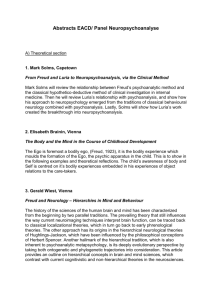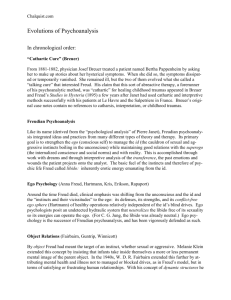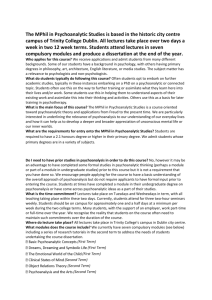ON CHOOSING A GUIDING THEORY FOR TREATMENT
advertisement
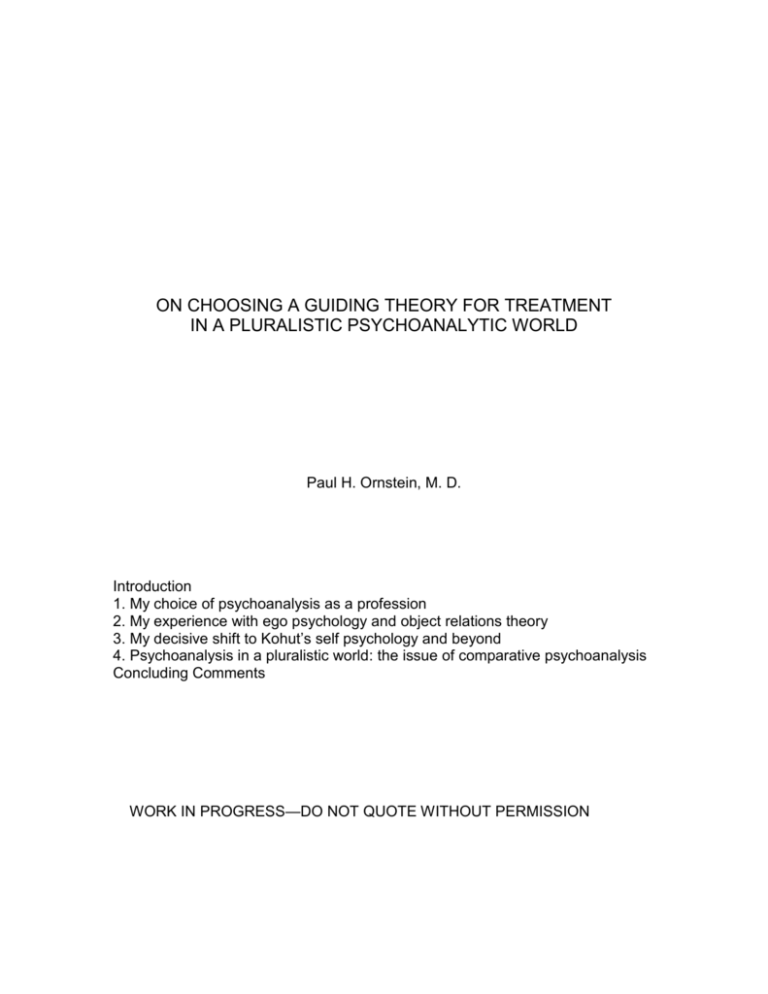
ON CHOOSING A GUIDING THEORY FOR TREATMENT IN A PLURALISTIC PSYCHOANALYTIC WORLD Paul H. Ornstein, M. D. Introduction 1. My choice of psychoanalysis as a profession 2. My experience with ego psychology and object relations theory 3. My decisive shift to Kohut’s self psychology and beyond 4. Psychoanalysis in a pluralistic world: the issue of comparative psychoanalysis Concluding Comments WORK IN PROGRESS—DO NOT QUOTE WITHOUT PERMISSION Introduction I have often been asked how it was that I have adopted Heinz Kohut’s self psychology so completely after having been trained in traditional psychoanalysis (ego psychology) and then was strongly influenced by Michael Balint’s object relations theory. Balint’s approach to psychotherapy and psychoanalysis significantly expanded, but did not fundamentally alter my basic Freudian paradigm. The questions I will address tonight is this: What led me to the drastic shift toward self psychology in my clinical and theoretical orientation? And what might that teach us about how we choose our guiding theory for psychoanalysis? It is through personal experiences (highly abbreviated as these must be for this presentation) that I wish to approach the topic of choice of a guiding theory in our pluralistic psychoanalytic world with these two questions in mind. I have chosen to reflect on the evolution of aspects of my own psychoanalytic career as a way to portray why and how I had become a self psychologist-psychoanalyst—and offer this as an example of how such choices may be made. Such choices are formed in each of us on the basis of our respective life-experiences, our personal analyses and training as well as our subsequent clinical work and our pre-existing and continually evolving Weltanschauung—meaning, that psychoanalysis (whether we like it or not) is a value-laden enterprise—and not a value-neutral one. Such considerations are also timely, because the current climate in psychoanalysis calls for an open dialogue between the various approaches, in 2 order to discover our commonalities as well as our differences and thereby enriching our own individual perspectives.1 I would like to make one more general comment. Although today there is no longer any need to justify the claim that our varied psychoanalytic approaches have significant roots in our respective life-experiences, it might still be worthwhile and clarifying to describe at the outset just exactly how these lifeexperiences influence the choices as well as the uses we make of our respective theories. The long held idea (Sandler, 1983) that, our personal, private, often unarticulated theories affect our clinical work more decisively on the “local” level, (that is, in the clinical moment), than do our public theories, and that our private and public theories are idiosyncratically amalgamated in each of our analytic practices—may not yet be generally acknowledged. This amalgamation of the two layers of our theories (the private and the public), are in my view at the core of our analytic treatment approaches. This explains a great many open questions in the field of psychoanalytic therapeutics.2 The subjective components of our amalgamated theories are most significant in the treatment process. Thus the two layers of our theories—the private and the public—direct us now to view each analytic process under scrutiny from within the experience of the two participants, rather than merely from the perspective of the viewers preferred public theory. The theme of this year’s International Psychoanalytical Congress was “Divergences and Convergences”— acknowledging these differences and encouraging a dialogue between the various psychoanalyses. 2 The whole issue of what is “curative” in psychoanalysis is tied up with the amalgamation of our private and public theories—how much our emotional participation, the analytic relationship (in contrast to our neutrality) contributes to the curative process. 1 3 But this was not always so. Until about the 1970’s psychoanalytic practice was captive of the prevailing theories, many of them formulated in the experience-distant language of metapsychology. Representatives of the various psychoanalytic theories were only interested in asserting the validity of their own, with marginal interest in competing theories. But practice since then has been progressively freed up from reliance on experience-distant theories. Analysts, groping for a more effective treatment approach without a systematic, experience-near theory, often made ad hoc changes in their responsiveness in the privacy of their offices. Thus, individual analytic practice has continued to change constantly, at a very slow pace over many decades, but the public theory that was to guide practice remained essentially unchanged. As a result the gap between theory and practice that developed became unbridgeable by the 1960’s. Many analysts complained about this gap.3 In the U.S. Kohut’s self psychology has undoubtedly led the way to bridge the gap between theory and practice—even if this was not generally acknowledged. In this particular presentation I will illustrate some of these changes in the first person singular—on the basis of my own Odyssey from ego psychology to Balint’s object relation theory and finally to Kohut’s self psychology and beyond. I will refer to the work my wife Anna and I have done jointly as well as individually regarding changes in our approach to the treatment process. Leo Stone attempted to “humanize” the analytic encounter by altering the prevailing strict ”neutrality” of the analyst but suggested no basic changes in the theory that guided he treatment process. 3 4 My presentation will consist of four parts: (1) I will comment in passing on my choice of psychoanalysis as a profession. (2) I will describe some of the vicissitudes of my experiences as an ego psychologist, including the expansion of my approach with Balint’s object-relations theory. (3) I will portray the essential elements of what led me to Kohut’s self psychology and beyond. And (4) I will finally conclude with a few remarks about comparative psychoanalysis. 1. My choice of psychoanalysis as a profession I will not dwell extensively on what led me to psychoanalysis in my middle teens. Actually it was quite accidental, although I could later reconstruct the developmental antecedents to this “accident.” But I was quite conscious of what drew me to the field after I moved to Budapest from my provincial birthplace in Hungary to study at the Gymnasium of the Reform Rabbinical Seminary. I arrived for my “entrance examination” on September 1, 1939—the fateful day WWII broke out as Nazi Germany invaded Poland. Within weeks after my arrival in Budapest, I was exposed to the study of Freud’s Interpretation of Dreams and Ferenczi’s Thalassa—both left lasting impressions in me. But at that initial moment Theodor Reik’s book, Ritual, became one of the magnets that drew me toward applied psychoanalysis, because it dealt with issues of my every-day life as a then still religiously observant Jew. Practically on the spot I decided that this was the field I wanted to pursue. 5 2. My experience with ego psychology and object relations theory My analytic training in this country was dominated by the prevailing ego psychology, centered on the dual drive theory, the Oedipus complex, and the centrality of interpretation of defense and resistance and the ego’s way of dealing with potentially pathogenic conflicts. In supervision, my analytic relation to my patients was often talked about as a non-specific, but important part of what permitted the crucial drive-defense interpretations to be effective: the so-called “therapeutic alliance.” Strangely—although I did not recognize this strangeness then—the emotional components of this relation were only specified in the recognition of my countertransference reactions as interferences and never as essential, subjective and inevitable components of the interpretive process. It is in this connection that Balint’s object-relations theory expanded and “humanized” my analytic-therapeutic approach. My feelings, reactions and fantasies mattered in the analytic process after all—I was not only a receptacle for the patient’s projections; I facilitated or retarded progress by what I felt, said and did. In addition to Balint’s emphasis on the analyst-patient relations as central in the treatment process his book, “The Basic Fault” (1968), with its exquisite and unsurpassed descriptions of archaic transferences (without clear guidelines for their treatment) prepared me for Kohut’s self psychology4. 4 Balint did not provide explicit guidelines for the treatment process beyond the idea that the analyst had to be with the patient. His idea that what we now call self psychology originated in the pre-verbal and early verbal period led him to believe that, verbal communication could not be effective at that level of archaic regression to the “basic fault.” Kohut offered us a language that could encompass these archaic experiences, if accompanied with the requisite emotional participation of the analyst in the treatment process. 6 I am not blaming ego psychology entirely, or Balint’s object relations theory, for my therapeutic shortcomings of that training period. I was eager to learn the public theory and its correlated conduct of the analyses of my patients; I wanted to do analysis “lege artis,” unaware of the power (therapeutic and otherwise) of my disavowed, unarticulated private theory that is inevitably a part of every analyst’s therapeutic approach. I will return to this issue later. I will now present two clinical vignettes: the first one highlights a fundamental difference between an ego psychological and a self psychological understanding of symptomatic behavior. The second one is an illustration of how the exclusion of my subjectivity (including my spontaneous reactions as part of my private theory) could have thwarted my therapeutic effectiveness. Failures and therapeutic impasses were sources of the important impetus for my continual search for a more effective clinical approach and an experience-near guiding theory5. My private theory had to do mainly with my later recognition that these two of my patients in supervised analyses would have needed my emotional participation in the treatment process. They could not work well analytically in a climate of strict neutrality and abstinence. One of these patients, Allen B, was a sensitive, secretive, troubled, married father of a boy and a girl, with ambitions to become a writer. But he was working (grudgingly) in the prosperous family business at that time and felt unable to devote himself to writing. Among his many diffuse problems and dissatisfactions in life he had a “compulsive need”—as he put it—to visit I speak of a “guiding theory” to avoid the notion of a “theory-driven” approach, in contrast to empathydriven one, in which the analyst’s relation to the patient is a significant component of the treatment process. 5 7 prostitutes. Only later, with considerable shame did he add that these were “black prostitutes.” Neither I nor my supervisor was able to find effective ways of understanding and responding to this issue and to the patient’s revelation of his secret. Allen B. made some progress in a number of areas but his visiting prostitutes remained as compelling in the third year of the analysis as it was at the beginning. The problem became more urgent for the patient since he began to fear accidental exposure and yet was unable to give up his need for these visits. Whatever my interventions were, these felt to him to be efforts on my part to stop his behavior. His inability to do so made him feel even more ashamed and helpless as well as more in need to engage in this compulsive behavior. These visits often happened when he felt slighted or humiliated at work or in social situations. When I suggested at one point in so many words that these visits might have had to do with his enjoyment of an illicit relation, since that was more enticing he mocked this kind of comment as preposterous and decided to leave the analysis after some three hundred sessions. My supervisor ascribed the patient’s leaving analysis to his “un-analyzable psychopathology” but I (privately) ascribed it to our failure to understand the nature of the compulsion. In the manner in which I made my interpretive comments I have implicitly criticized the patient’s behavior, rather then trying to understand it. And when I finally focused on the pleasure he seemed to need 8 and enjoy from his illicit relations with black prostitutes (who were as different from his mother as could be) he “had enough” and left.6 Only much later, during my post-training supervision with Heinz Kohut did I finally understand better what happened in this analysis and why my analytic efforts failed to be helpful to Allen B. From the perspective of the new theory it was central to understand the compulsive nature of the behavior. In self psychology theory, symptomatic behavior is not judged in relation to a hypothetical norm, in which the goal of analysis is to remove the defenses layer by layer, in order to expose to the patient the unacceptable truth: his sexual and murderous impulses. Rather, in this theory symptoms—and defenses in general—are recognized as protecting a vulnerable self from further fragmentation. I was aware of the fact, that his need to visit a prostitute would become imperative when the patient felt particularly demeaned or humiliated. The sexual experience, which could never be as gratifying with his wife as with the black prostitute, appeared to reestablish his psychic equilibrium, the cohesion of his brittle self. Had I centered my interpretive comments on the function of these visits—what these had to accomplish for him—Allen B. might not have experienced my interventions as efforts on my part to take away his only means to restore his equilibrium. In addition, he would have felt accepted and understood by me rather than criticized. His compulsive behavior would have made sense to both of us. 6 I am not suggesting that someone else, with a different amalgam of his public and private theories might not have been able to conduct this analysis satisfactorily without altering his public theory as I did later on. However, at this point I have still conducted what I would call a “theory-driven” analysis with the supervisory help I received. 9 Understanding of Allen B’s motivation for his defensive and symptomatic behavior helps to explain how therapeutic action is conceptualized in self psychology. In this theory it is the feeling of being understood in depth that permits the abandonment of maladaptive and self-destructive behavior: feeling understood establishes a sense of self-cohesion, without the need to resort to defensive and symptomatic behavior. Another patient of mine, Cary V. was a successful business man; married and father of four children. He came into analysis because of an unbearable conflict with his elderly father, causing him, as he said, a variety of psychosomatic symptoms. His father would not relinquish his financial control over the business, although it was his son who did now all the work in connection with running and expanding the business, hoping that he would finally become the owner. He was ready to buy out his father’s share. He once obtained the promise that he could do so and then the father reneged on his verbal agreement—this and some other family issues led to constant tension between father and son. The analysis revealed that beneath his quarrelsome, angry outbursts at his father Cary V. desperately wanted to elicit his father’s love and admiration but he also feared the father’s violent temper. He often described painful memories of his father’s arbitrary, severe punishments for minor transgressions in his childhood. Both the fear of his father and the relentless search for his love entered Cary V.’s analytic experience, which was then interpreted, (almost 10 exclusively), as an expression of transference repetition, emerging entirely from within, without being related to and often triggered by my interpretive comments. My analytic behavior and interventions were guided by the rule of neutrality and abstinence demanded by the public theory. This appeared to have intensified the patient’s search “for a loving father”—manifested in a variety of ways in the transference and led to his frequently expressed, intense frustrations. One such manifestation was his lengthy reflection before a Christmas vacation about what kind of present he should give me—a token present or an expensive one. When he brought the present, I took it and thanked him for it. My impulse was to open it, but fearing that simply accepting the present would make it gratifying and therefore impossible to analyze it, I placed the gift on the table and proceeded to explore its meaning. The gift remained unopened until after Christmas and we continued to analyze its possible meanings, until V. came to the conclusion that giving me the present was “inappropriate.” Today we know that accepting the gift would not have prevented exploring and understanding the meaning of his gift to me. The portrayal of the aftermath of this episode would take us far-a-field. My refusal to accept the gift led, in my current language, to a painful feeling of rejection and disruption of Cary V’s selfobject transference. Fortunately, later, the disruption was repaired and V. successfully terminated his four-year analysis. These two samples stand for my early supervised clinical experiences. These led me—as I mentioned before—to a continual search for improving my analytic responsiveness. I was in search of a theory that would reliably guide me 11 into the inner world of the patient, to his or her subjective experience. This search, I believe, was fueled by my earlier interest and writings about empathy (Ornstein, PH and Kalthoff, R. J. 1967, Ornstein, PH 1968). The kind of theory I was searching for I found in Kohut’s evolving self psychology, especially in that he placed the method of empathy into a central position in his approach to psychoanalysis (Kohut, 1959, 1971, 1977, Ornstein PH, 1978a). Let me sum up what I have said so far. I have sketched my personal and psychoanalytic journey as these are, on many levels, inevitably intertwined. I have included early interests, accidental influences; clinical experiences—and illustrated in two clinical vignettes samples of what my patients taught me about how to analyze them—mainly, in terms of how not to behave in relation to the patient and what not to do. These vignettes also portray a paradox: analysts have always known and talked about the importance of their own emotional presence in the analytic encounter. This is how Freud stated this in 1937: “. . . among the factors which influence the prospects of analytic treatment and adds to the difficulties in the same manner as the resistances, must be reckoned not only the nature of the patient’s ego, but [also] the individuality of the analyst.” So, clearly, the analyst’s individuality could not be excluded, it was recognized as significant! Furthermore, Freud stated already in 1910 that “We have noticed that no psychoanalyst goes further [with his patient] than his own complexes and internal resistances permit.” So, again, the analyst’s subjectivity inevitably matters. 12 I would like to add here just one additional statement as to why self psychology had become my psychoanalysis. Self psychology became my psychoanalysis because it accommodates various subtle meanings of the concept of “relation”—actually a more accurate phrasing would be (instead of relation): how the patient experiences the analyst. This is a key element of Kohut’s psychoanalytic paradigm—this meaning is inherent in the conceptualization of the selfobject. My quick acceptance of it occurred because in the 1960’s, in my effort to delineate the nature of the psychotherapeutic process (before my acquaintance with self psychology) I have myself come very close to the conception of the selfobject—without, of course, using that term and without realizing its wider meanings. This is what I wrote then: “When something goes wrong in the innate or experiential aspects of . . . development and maturation, this has its effects upon the structures and functions of the mental apparatus and on the nature of the self in its relatedness to others. From then on the self attempts, forever-after, in innumerable, unique ways to make use of others as if they were those primary objects in relationship to whom the needs, wishes, and strivings of the self have never worked our satisfactorily. Life [then] becomes a permanent struggle for reparations and not for mutual gratification and sharing” (Ornstein, PH, 1967a, italics added here). Kohut’s conceptualization, however, added several important dimensions which were missing in my definition of the selfobject: Kohut made it explicit that it was the patient’s experience of the analyst, to be recognized via empathy that ought to be the focus of clinical psychoanalysis. The selfobject concept is thus 13 inextricably linked to empathy as the method of observation and is an integral part of Kohut’s epistemology. The method of observation determines the nature of the data obtained. The data then, for psychoanalytic self psychology, are what become illuminated through the patient’s subjective experience. This, I believe, along with my own abiding prior interest in the centrality of empathy, accounts for why I have decisively shifted to Kohut’s self psychology and adopted it as my guiding theory. This also accounts for my groping steps ever since, (mostly jointly with Anna) to move beyond Kohut’s own formulations in the therapeutic realm—which I will condense for this presentation. 3. My decisive shift to Kohut’s self psychology and beyond After graduating from the Chicago Institute, I was in bi-weekly supervision with Kohut, over a four-year period. In presenting to him the analysis of a patient I became acquainted with his mode of thinking and with the clinical process, guided by his then emerging self psychology—he was just then writing The Analysis of the Self. I learned that patient and analyst bring to their relation unique aspects of their subjectivities—including their vulnerabilities. It was then that I learned that what matters most is how the patient experiences the analyst—the role and function the analyst serves the patient in his inner world—the selfobject transference. Such a selfobject transference is not only a repetition, it is also expressive of the patient’s yearning for new experiences. In my supervisory experience with Kohut, a new, panoramic view of the patient’s inner world opened up for me in such a compelling manner that some of 14 my previous analytic experiences in their hitherto obscure areas also became illuminated. As a result, all of my four obligatory, supervised analyses appeared retrospectively in a different light, richer and more immediately meaningful. Kohut’s concepts of the selfobject transferences thus came alive for me. Often quite painfully, since I had to recognize the limitations of my responsiveness to the patient’s transference needs. As a result I understood what Kohut meant by “experience-near” theorizing and analytic responsiveness. His formulation of the selfobject—reconstruction from selfobject transferences—at once as a developmental, clinical and theoretical conception increasingly made more sense to me. Hence, I experienced my patients’ selfobject transferences as a felicitous conceptualization of what they brought to their analyses, namely, their deficiencybased conflicts as well as their yearning for new experiences. The patient I presented in supervision to H K was my first encounter with self psychology. The experience was most instructive and transforming, in that it led me to a level “deeper than the patient’s Oedipus complex.” It led to my patient’s profound self-regulatory difficulties and his noisy clamoring for admiration and validation, which I would not have known how to address before. This posttraining supervision broadened my horizon as to what could be encompassed in a psychoanalytic treatment process. The specific content of what patients wanted for their repair or cure (i.e. mirroring and idealization) emerged for me in this supervision and deepened later as a result of studying all of Kohut’s writings. It was in the context of this analysis that I also learned the new meaning of defenses as protectors of a vulnerable self; obstacles not to be “removed and 15 confronted” but empathically (that is, from the patient’s own perspective) understood and interpreted. As I learned about Kohut’s approach, I was also able to reflect on the repetitive obstacles presented by my prior public theory and the thwarting impact of that theory on my ability for appropriate emotional participation in the analysis—which I previously thought needed to be subordinated to, or controlled by, the prevailing public theory I was eager to master. The concept of the selfobject transferences aided my gradual transition to a more naturally responsive participation in this supervised analysis and in my subsequent clinical practice. A more detailed description of this practice and the theory that guides it cannot be included in this brief presentation. Instead I will comment on the increasing need and method for a comparative psychoanalysis. 4. Psychoanalysis in a pluralistic world: the issue of “comparative psychoanalysis.” A great deal more would have to be said about “psychoanalysis in a pluralistic world” than I am prepared to include in this presentation. I will therefore restrict myself to a few brief remarks on one important aspect of our contemporary dilemmas: the method of comparative psychoanalysis. There is no human experience that does not appear in some form or other in specific contexts, in all contemporary psychoanalytic encounters. But not all of those that appear have a distinct, significant theoretical position in all these analytic approaches. Such is the case, for instance, with the experience of envy 16 (to use one example) in psychoanalytic self psychology. Envy does not have a special theoretical position in self psychology—as it does, for example, in Kleinian theory. Envy is seen in self psychology as one of the many possible consequences of an enfeebled, fragmentation-prone or fragmented self and can have varied meanings and functions as a response to whatever has triggered envy during early development or triggers it later in the psychoanalytic treatment process. Envy is seen in self psychology as a secondary phenomenon, having either a conscious, preconscious or unconscious quality. It is unconscious envy that is perhaps most problematic and in need of specific analytic attention in the treatment process. What makes “cross-cultural,” comparative psychoanalysis difficult is that not every one of our inner experiences has a theoretical position in a particular public theory. The fact that experiences in any analysis occur in a dyadic setting (hence specific to that dyad) was always true, even when unacknowledged and reduced to, or emphasized only in its intrapsychic meaning; and that only for one of the participants. The era, in which the analyst was not considered an active participant, but only an observer and a periodic commentator on the patient’s experience and was only as a recipient of the patient’s projections—is now largely history. In our pluralistic psychoanalytic world, we are challenged to spell out and illustrate our method of reaching across the many theoretical and clinical divides, in order to understand each other and learn from each other. The interest in comparative psychoanalysis is evident in many panel presentations and published essays in which clinical reports are now regularly 17 discussed by two or three analysts of different theoretical persuasions. For that reason I have to describe here briefly my approach to reaching across the divide, both to the theoretical and to the clinical issues in an analysis, conducted from a different psychoanalytic perspective. A reasonable appraisal of a clinical report that is not my own, necessitates my entry into the other analyst’s mode of thinking and working. That requires that I temporarily “adopt” the other analyst’s theory in order to grasp the essence of the clinical process presented and then examine how that analyst’s emotional participation as well as his/her guiding theory influenced the clinical work. It is only after I immerse myself in the other analyst’s way of thinking and working, can I meaningfully appreciate and assess the analyst’s use of herself/himself and the theory that guided the treatment process. I consider this to be essential to the study of comparative psychoanalysis. It is good to remember that, even in our current, pluralistic psychoanalytic world there are no analytic systems without some, and occasionally extensive, similarities in the various core concepts in all theories. On closer inspection, however, it turns out that some of these concepts that appear to be similar, are embedded in different basic assumptions, in a different Weltanschauung, a different view of the human condition as well as a different expectation of how and what analysis is to accomplish. Any in-depth comparative analysis also has to involve these broader fundamental issues, even when these are not explicitly included in the particular psychoanalytic theoretical system under discussion. 18 It is the patient’s and the analyst’s subjectivity (broadly encompassed) that makes each psychoanalytic treatment effort unique. Any commentator on any analysis conducted by another analyst has to reach, therefore, an understanding from the clinical report of how the analyst deployed or attempted to withhold his or her subjectivity and responsiveness in the treatment process. This assessment can only be made by an empathy-based entry of the external observer into the analytic process in order to understand the participants’ experiences from within their own perspectives. Concluding Remarks I have reached the end of my presentation. I have portrayed aspects of my clinical experience which ultimately led me to choose Kohut’s experience-near guiding theory for my practice, with the explicit aim of trying to improve the therapeutic impact of my analytic work. My pre-analytic psychotherapeutic experience led me to recognize what my patients needed and often demanded for their “cure.” These needs and demands necessitated a psychoanalytic approach in which transferences were recognized as not being only repetitions but were also expectations that in this unique relationship certain developmentally needed experiences will also have to be responded to. There were historically good reasons for the approach Freud advocated. As you recall, he defined psychoanalysis as a three-pronged approach: (1) a psychoanalytic theory of the mind; (2) a method of investigating psychological 19 phenomena; (3) a form of therapy. And he was mainly interested in how the mind works and for that purpose he developed a “laboratory setting”—the psychoanalytic situation—in which the analyst behind the couch was to be exchangeable and the method of analysis as well as the theory had to be essentially standardized. Freud left the therapeutic impact of a “well conducted” analysis to the synthetic function of the patient’s ego. But that worked only for the “healthy neurotic” patients. For others, the analyst could not rely on the synthetic function of the patient’s ego for transforming insight into cure. Decades of clinical experience—for me, especially the emergence of self psychology—culminated in the recognition that the therapeutic impact of psychoanalysis resides in combining a multidimensional, emotionally responsive relation to the patient along with the analyst’s insight-oriented interpretive activity. Thus, it appears that the psychoanalytic study of the mind and the psychoanalytic method of therapy are two different procedures within an overarching psychoanalysis; with many, inevitable linkages. In other words, the goal of the study of how the mind works and how the treatment process needs to be conducted appear to be two different processes with, at times, overlapping procedures. I would like to leave you with the following disconcerting (?) thought: Regarding the therapeutic-side of the procedure it is well to recall that there are eight or ten different, major (and a few lesser) psychoanalytic systems that comprise our pluralistic psychoanalytic world. If all of these are “bona fide” psychoanalyses (as represented in the International Psychoanalytical Association) 20 it might well be that the essential part of the therapeutic approach is the prolonged, intense, inevitable, emotional connection between patient and analyst—but especially the way the patient experiences the analyst—that is activated in all analyses. For such a process the analyst’s (innate and experientially refined) empathy needs an experience-near guiding theory for how to talk to the patient and what to focus on—that are the essential common elements of the treatment process—whatever the guiding theory of each analyst is.7 7 This does not mean that the specific theory is unimportant for each analyst, but we have no compelling research-based data to make these choices. It is the accidental encounters or the deliberate choices that lead to the adherence to a particular theory. This may be held lightly or firmly, depending on its seamless amalgamation with each analyst’s personality, weltanschauung and clinical experience. The emphasis here is on an empathy-based clinical approach that is thought to supply the conviction for analyst and patient on the basis of an understanding they jointly arrive at for the meaning of their experiences. It is taken for granted that clinical experience may continually modify the analyst’s private theory and affect his or her use of his adopted public theory. 21 “The miracle of creation is that unity in Heaven produces diversity on earth. Torah is the rain that feeds this diversity, allowing each of us to become what only we can be.” [Covenant and Conversation—Ha’azinu] “I understood her . . . because in her I understood myself and in my self [I understood] her. [In “The Name of the Rose” by Umberto Eco, p. 280] 22
